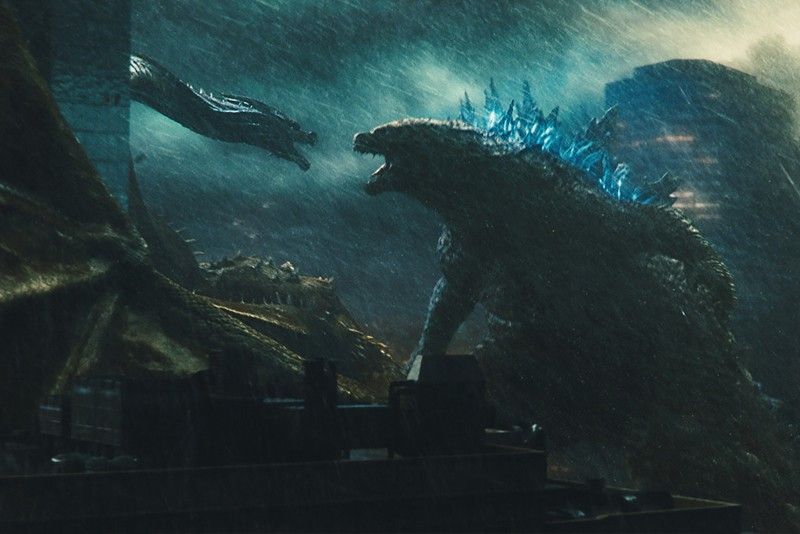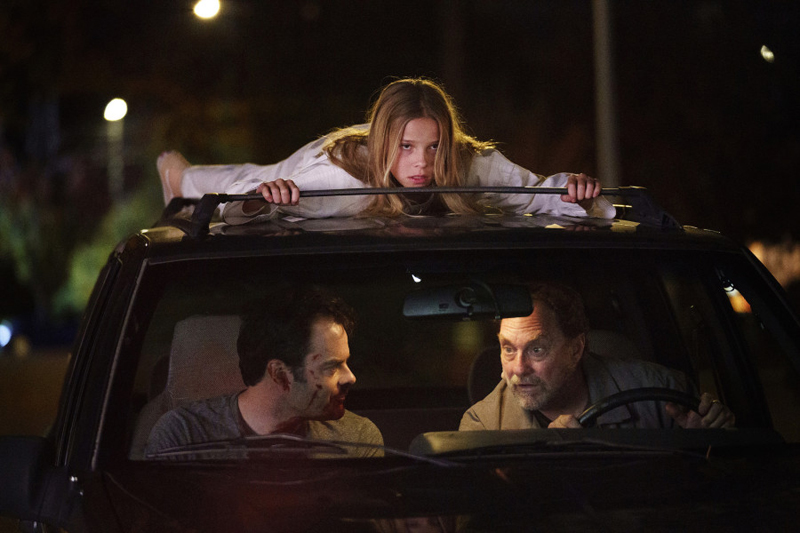Godzilla’s back (and ready to rumble)

It’s no spoiler to say that, somewhere in its original 2014 reboot, Godzilla shifts from being a 350-foot-tall destructive behemoth to occasional protector of the planet. When various kaiju (Japanese monsters) rise up from their lairs, drawn to radioactive energy, human military might — atomic bombs and weapons — can’t take them down. It takes a lumbering kaiju with a dad bod to drive them back into the dirt.
Under Warner Bros. Pictures’ reboot franchise, all the classic Toho studios monsters of 1960s fame are back, and Godzilla II: King of the Monsters stays remarkably true to accepted Godzilla cinematic lore, while updating things and adding some mythical prehistoric origins.
That means fans of the old, rubber suit-wearing movies will groove on Mothra, Rodan, and three-headed Ghidora, all ready to play.
But this being a modernized version of kaiju, the creatures are CGI and their scale is ginormous. Awesome scenes of destruction ensue, equal to Avengers: Endgame — all of it played out against a backdrop of a smoldering US Capitol in Washington, DC, and Boston’s Fenway Park. Cool.
What does it all signify? Not much, unless you’re a kid who grew up watching Saturday morning “Creature Feature” movies from Japan and trying to replicate those moments with toy train sets, plastic models and 8mm cameras. (Full disclosure: Me.)
It’s five years after Godzilla disappeared under the sea in the earlier movie, and Kyle Chandler plays scientist Mark Russell, estranged from his wife and daughter (Vera Farmiga and Stranger Things’ Millie Bobby Brown, good in her film debut) ever since Godzilla’s first romp through San Francisco left their son dead. He now finds himself recruited to help track the creature’s whereabouts, using a bio-sonar device called Orca developed with wife Emma to lure whales away from beaching themselves. But Monarch — the secret government program that was also monitoring King Kong back on Skull Island — has appropriated Orca to control large hibernating kaiju in strategic spots throughout the globe.
Monarch — its name echoing a certain conspiracy theory about mass mind control experiments conducted by the US government — is still a sketchy enterprise here, but vaguely villainous overtones emerge from two HBO alumni — Silicon Valley’s Thomas Middleditch as a Monarch operative and GoT’s Charles Dance as eco-terrorist Jonah Alan who wants to let the kaiju do their thing in order to save the planet… from us.
Meanwhile, as the government tries more frantic means to stop the monsters (including an oxygen-destroying trick that failed even back in the 1954 original), Ken Watanabe’s Dr. Ishiro Serizawa, Sally Hawkins’ Dr. Vivienne Graham and Zhang Ziyi’s Dr. Ilene Chen argue that Godzilla is a positive force, one of the “original titans” who can set Mother Nature back to balance. That means stepping aside and letting the Green Guy do his thing.
What makes Godzilla — a character played by a man in a rubber suit in the 1954 Toho original — so enduringly popular? Put simply, Godzilla got soul. If he were merely a radioactive-breathing green monster crushing things underfoot, Godzilla would not have lasted through 35 movies. Like King Kong (scheduled to appear in a grudge match with Godzilla in 2020, following his emergence in Kong: Skull Island), the Big Green One plays on our sympathies.
Action-wise, new director Michael Dougherty (taking over for Gareth Edwards) pays detailed attention to the things about those ’60s movies that sparked our imaginations — the primal reveal of these kaiju from earthbound hibernation, the sheer scale of monsters set against tiny, smoking cityscapes, plus a few classic wrestling moves and mid-air battles — yet he makes it fairly attractive to new viewers as well (well, perhaps younger viewers more so than jaded adults).
The plot, such as it is, is constructed to set the kaiju loose and watch them pair off in a series of tag-team tussles. There are shades of eastern yin-yang harmony as well — the appearance of Mothra is very Earth Mother, radiating luminous light and emitting an otherworldly hum. We also get a glimpse of a sunken prehistoric civilization, hinting that the kaiju were mankind’s “original gods.”
Rodan emerges from the molten ash of a volcano, much like a Phoenix, and pulverizes military jets with sonic booms; Mothra is generally chill and peaceful, until faced with a threat; and again, if you miss GoT’s trio of dragons, you get three for the price of one in Ghidora.
Charles Dance supplies his usual withering stare, much missed since Tywin Lannister’s unfortunate demise in GoT (it’s hard to keep a good villain down); Chandler works up the Toxic Masculinity for much of the movie, getting pissed and going off half-cocked; Millie Bobby Brown proves she’s ready for something a little more demanding on the big screen; and Bradley Whitford basically coasts along, though he does score his usual share of one-liners and burns. But let’s face it: it’s — not surprisingly — the full-on kaiju dustups that pack the bigger punch. Basically, we’re here to enjoy watching big monsters battle amid tiny cities. Just like in the old days. And Godzilla is, once again, someone you root for, dad bod and all.
HBO’S ‘Barry’ kills in Season 2

Bill Hader and Stephen Root fear for their lives in Season 2 of HBO’s Barry.
There’s a moment in Season 2 of HBO’s Barry where the show actually transcends itself, breaks the template and shoots off the charts. Like Gene Cousineau’s Hollywood acting hopefuls — including Bill Hader’s reluctant assassin — it takes flight, soars into unscheduled hilarity, and doesn’t look back.
That’s Episode 5 (“ronny/lilly”), written and directed by Hader himself. In it, Barry is forced to eliminate a police detective’s romantic rival, who turns out to be a Taekwando master. As an added bonus, his daughter is a feral, tree-climbing white belt who doesn’t make it any easier for the assassin who wants to get out of the game.
Just in time, the show got a shot of raw adrenaline, spinning off into a real-time episode about a “job gone wrong” that takes the show leagues away from its template. Think of The Sopranos’ “Pine Barrens” episode, or that True Detective Season 1 stash house raid episode with a 20-minute unbroken cut. Those standalone episodes make the show stronger by revealing there are no rules.
It’s not like Barry had dropped in quality. But Hader’s HBO series about a US vet who goes from killing in Afghanistan to taking paid hit jobs from an unsavory Stephen Root had such a strong opening, it was only a matter of time before we began to see the patterns of series fatigue kick in: Root, playing Fuches, the wily old family friend who steers Barry into murder-for-hire as a Stateside career option, will keep getting into jams, and Barry will have to get him out; girlfriend Sally (Sarah Goldberg) will go from being supportive to displaying her selfish side and weaknesses. Etc.
Hader, as Barry Berkman, has his own existential crisis to work through, which is fine; but continuing to surprise us are Glenn Fleshler’s eyebrow-less Chechen would-be mobster Goran; and of course, Henry Winkler in a twilight role of a lifetime, showing Barry the mentoring he found so hard to give his own son.
Season 2 delivers on the promise of Season 1 (a boatload of Emmies probably added some encouragement), and just when you thought you’d never want to see another assassin TV show, Barry proves them all wrong by pushing that envelope.















